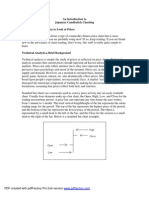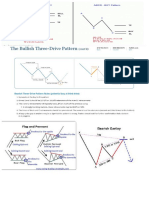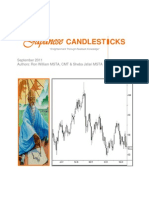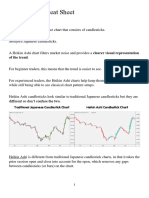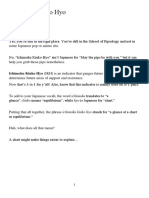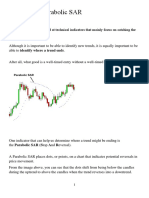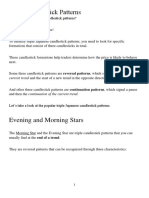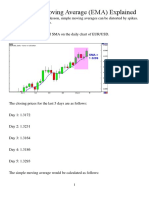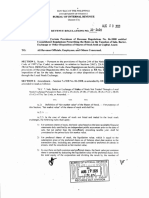Basic Japanese Candlestick Patterns
What do spinning tops, marubozus, and dojis have in common?
They’re all the basic types of Japanese candlesticks!
Let’s take a look at each type of candlestick and what they mean in terms of price
action.
Spinning Tops
Japanese candlesticks with a long upper shadow, long lower shadow, and small real
bodies are called spinning tops. The color of the real body is not very important.
The Spinning Top pattern indicates the indecision between the buyers and sellers.
The small real body (whether hollow or filled) shows little movement from open to
close, and the shadows indicate that both buyers and sellers were fighting but nobody
could gain the upper hand.
Even though the session opened and closed with little change, prices moved
significantly higher and lower in the meantime.
Neither buyers nor sellers could gain the upper hand, and the result was a standoff.
1
�• If a spinning top forms during an uptrend, this usually means there aren’t many buyers
left and a possible reversal in direction could occur.
• If a spinning top forms during a downtrend, this usually means there aren’t many
sellers left and a possible reversal in direction could occur.
Marubozu
Sounds like some kind of voodoo magic, huh? “I will cast the evil spell of the
Marubozu on you!”
Fortunately, that’s not what it means. Marubozu means there are no shadows from
the bodies.
The word “marubozu ” translates to “bald head” or “shaved head” in Japanese.
So a Marubozu candlestick is a bald candle or shaved candle means it has no shadow
or wick.
Depending on whether the candlestick’s body is filled or hollow, the high and low are
the same as its open or close.
Check out the two types of Marubozus in the picture below.
2
�A White Marubozu contains a long white body with no shadows. The open price
equals the low price and the close price equals the high price.
This means that the candle opened at its lowest price and closed at its highest price.
This is a very bullish candle as it shows that buyers were in control of the entire
session. It usually becomes the first part of a bullish continuation or a bullish reversal
pattern.
A Black Marubozu contains a long black body with no shadows. The open equals
the high and the close equals the low.
This means that the candle opened at its highest price and closed at its lowest price.
This is a very bearish candle as it shows that sellers controlled the price action the
entire session. It usually implies bearish continuation or bearish reversal.
Depending on where a marubozu is located and what color it is, here are few
guidelines:
White Marubozu
3
�• If a White Marubozu forms at the end of an uptrend, a continuation is likely.
• If a White Marubozu forms at the end of a downtrend, a reversal is likely.
Black Marubozu
• If a Black Marubozu forms at the end of a downtrend, a continuation is likely.
• If a Black Marubozu forms at the end of an uptrend, a reversal is likely.
Doji
Doji candlesticks have the same open and close price or at least their bodies are
extremely short. A Doji should have a very small body that appears as a thin line.
Doji candles suggest indecision or a struggle for turf positioning between buyers and
sellers.
Prices move above and below the open price during the session, but close at or very
near the open price.
Neither buyers nor sellers were able to gain control and the result was essentially a
draw.
There are FOUR special types of Doji candlesticks.
The length of the upper and lower shadows can vary and the resulting forex
candlestick looks like a cross, inverted cross, or plus sign.
The word “Doji” refers to both the singular and plural form.
4
�When a Doji forms on your chart, pay special attention to the preceding candlesticks.
If a Doji forms after a series of candlesticks with long hollow bodies (like White
Marubozus), the Doji signals that the buyers are becoming exhausted and
weakening.
In order for the price to continue rising, more buyers are needed but there aren’t any
more! Sellers are licking their chops and are looking to come in and drive the price
back down.
If a Doji forms after a series of candlesticks with long filled bodies (like Black
Marubozus), the Doji signals that sellers are becoming exhausted and weakening.
In order for the price to continue falling, more sellers are needed but sellers are all
tapped out! Buyers are foaming in the mouth for a chance to get in cheap.
5
� While the decline is sputtering due to a lack of
new sellers, further buying strength is required to confirm any reversal.
Look for a white candlestick to close above the long black candlestick’s open.
In the next following lessons, we will take a look at specific Japanese candlestick
patterns and what they are telling us.
Hopefully, by the end of this lesson on Japanese candlesticks, you will know how to
recognize different types of candlestick patterns and make sound trading decisions
based on them.



